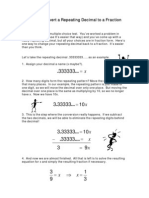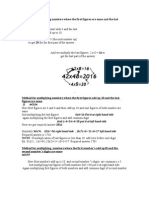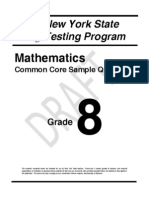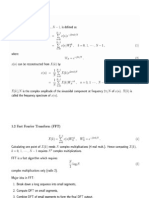Chapter 3 Summary
Chapter 3 Summary
Uploaded by
api-206106159Copyright:
Available Formats
Chapter 3 Summary
Chapter 3 Summary
Uploaded by
api-206106159Original Title
Copyright
Available Formats
Share this document
Did you find this document useful?
Is this content inappropriate?
Copyright:
Available Formats
Chapter 3 Summary
Chapter 3 Summary
Uploaded by
api-206106159Copyright:
Available Formats
By Carly Zech
Chapter 3 Multi-step
Equations and Inequalities
Zech, Caroline Monday, November 18, 2013 8:24:30 AM Pacic Standard Time 70:56:81:a9:71:6b
I. Distributive Property
The Distributive Property lets you multiply a sum by multiplying each addend
separately and then add the products.
4 x 53
(4 x 50) + (4 x 3)
200 + 12
212
I. Associative Property of Addition/
Multiplication
The associative property states that you can add or multiply regardless of how
the numbers are grouped. By 'grouped' I mean 'how you use parenthesis'. In other
words, if you are adding or multiplying it does not matter where you put the parenthesis.
Add some parenthesis any where you like.
2 + 7 + 5 = 2 + 7 + 5
( 2 + 7 ) + 5 = 2 + ( 7 + 5 )
( 9 ) + 5 = 2 +( 12 )
14 = 14
I. Commutative Property of Addition/
Multiplication
The Commutative property states that order does not matter. Multiplication and
addition are commutative.
Addition: 4 + 2 = 2 + 4
Multiplication: 4 2 = 2 4
Chapter 3 Multi-step
Equations and Inequalities
Zech, Caroline Monday, November 18, 2013 8:24:30 AM Pacic Standard Time 70:56:81:a9:71:6b
II. Simplify 4(7x-3)+2x
4(7x -3) + 2x
To simplify this equation...
First you would use the distributive property and multiply 4 X 7x which is 28x.
Then you would multiply 4 X 3 which is 12. Now the equation is 28x - 12 + 2x
Now you combine like terms. 28x - 12 + 2x. You would do 28x + 2x which is 30x.
Now the equation is 30x - 12. That is as far as you can simplify the equation so you are
done.
III. Solve 7x-10-9x=-13
7x-10-9x=-13
To solve this equation...
First you would combine like terms on the left side of the = sign. You would do this
because you need the -13 to solve the equation. So you would combine like terms, so
you would do 7x-9x which is -2x. Then the equation would = -2x-10=-13. Then you
would use the number furthest away from the variable which is 10. You would add 10 to
-10, which cancel each other out. Then you have to do this to the other side which is -13
+ 10 = -3. Now the equation is -2x = -3. Now you divide -2 by -2, they cancel each other
out. You have to do this to the other side so now you divide -3 by -2x. Then you drop
down the variable x = ... Now you can just divide -3 by -2 which is 1.5. So X = 1.5.
IV. Solve
Chapter 3 Multi-step
Equations and Inequalities
First you have to take away the fractions so you put
parentheses around the rst side and then you have to
do it to the rst side. So all of the denominators go into six
so you write six on the side of the parentheses. Now you have to look at six and say how
many times does 6 go into 6. Its one. Because its one you do 1 time 5x which is 5x, you
bring this down. You do this to all of them. 3 goes into 6 twice. two times x is 2x. Now you
have 5x+2x.... Now how many times does 2 go into 6. 3 times, 3 times 1 is 3. 5x+2x-3=...
Now you have to do this to the other side. 6 goes into 6 1 time. 1 times 11 is 11. 5x
+2x-3=11. Now you have to combine like terms. 5x plus 2x is 7x. 7x-3=11. Now you add 3
to both sides. 3 and 3 cancel each other out. 11 plus 3 is 14. Now its 7x=14. Now you
divide 7 to both sides. 7 and 7 cancel each other out. Now your left with an x so you bring
it down. Now you do it to the other side so 14 divided by 7 is 2 so x=2
6 3 2 6
Zech, Caroline Monday, November 18, 2013 8:24:30 AM Pacic Standard Time 70:56:81:a9:71:6b
V.
Chapter 3 Multi-step
Equations and Inequalities
To solve this rst you would multiply -5 by -5. They cancel each
other out. You have to do the same to the other side so 2 times -5
is -10. Which gives you -10 " X or X " -10. But because the equation
has negative numbers in it you have to switch the sign so the answer
would be X # -10.
VI. Solve and Graph -4x + 4 ! -8
First you take the number furthest away from the variable which is four.
Because its a positive number you need to subtract it from both sides. So
you subtract four from four which cancel each other out. Then you would
subtract if from -8 which is -12. Now you are left with -4x # -12. Now you
divide -4 by -4. They cancel each other out so you bring down the x. Now
you have to divide -4 by -12 which is -3. So x # 3. Because the numbers in
the equation are negative you have to switch the greater than or equal to
sign. So the answer is x " 3.
VII. Open Circle and Closed Circle
An open circle is when the number is not part of the solution. A closed
circle is when the number is part of the solution.
Closed
Circle
Open
Circle
Zech, Caroline Monday, November 18, 2013 8:24:30 AM Pacic Standard Time 70:56:81:a9:71:6b
VIII. Solve Inequality Word Problems.
Chapter 3 Multi-step
Equations and Inequalities
Chris wants to buy a bicycle that costs $160. If she saves $12 each week, what
is the fewest number of weeks she must save in order to buy the bicycle?
12x#160. You now divide 160 by 12. You bring down the x so x # 13.33. Now
you graph it.
13.33
Mark worked on math homework less than 1/3 the amount of time that his brother did.
If Mark spent 25 minutes on his math homework, how much time did his brother
spend on his math homework? 1/3x < 25. First you divide 1/3 by 1/3, they cancel each
other out. You have to do this to the other side so 25 by 1/3 which is 8.3 repeating. So
x < 8.3 repeating.
One third of a number, decreased by thirty-six, is at most twenty-two. Find the number.
This equation is 1/3x - 36 " 22. First you add -36 to 36. They cancel each other out.
Because you did it to this side you have to do it to the other. So you do 22 + 36. This
equals58. Now the equation is 1/3x " 58. Now you divide 1/3 by 1/3. They cancel each
other out. Because they cancel each other out you are left with x, so you have to bring
the x down. Because you did this to the rst side you have to do it to the other. So you
divide 58 by 1/3. This equals 19.3 repeating. So x " 19.3 repeating.
19.3
Zech, Caroline Monday, November 18, 2013 8:24:30 AM Pacic Standard Time 70:56:81:a9:71:6b
You might also like
- CSEC Mathematics June 2017 Paper 1 Solution 2017Document9 pagesCSEC Mathematics June 2017 Paper 1 Solution 2017steve hope75% (8)
- Homo HabilisDocument3 pagesHomo Habilisapi-194648813No ratings yet
- Multivariable Calculus With Vectors: Hartley Rogers, JRDocument10 pagesMultivariable Calculus With Vectors: Hartley Rogers, JRKshama Singhal0% (1)
- Chapter 3 SummaryDocument9 pagesChapter 3 Summaryapi-207047212No ratings yet
- Chapter 3 SummaryDocument9 pagesChapter 3 Summaryapi-207047212No ratings yet
- Math ProjectDocument3 pagesMath Projectapi-208339650No ratings yet
- Chapter3 SummaryDocument3 pagesChapter3 Summaryapi-208377344No ratings yet
- Linear Equations in One Variable: Exactly TheDocument14 pagesLinear Equations in One Variable: Exactly TheJane PadillaNo ratings yet
- CH 3Document11 pagesCH 3api-2083797440% (1)
- Chapter SummaryDocument11 pagesChapter Summaryapi-201420601No ratings yet
- Chapter 3 Multi-Step Equations And: InequalitiesDocument11 pagesChapter 3 Multi-Step Equations And: Inequalitiesapi-208379744No ratings yet
- MC Simplelinear 20090 1Document2 pagesMC Simplelinear 20090 1Nics GarciaNo ratings yet
- LInear Equations One Variable Examples & SolutionsDocument11 pagesLInear Equations One Variable Examples & Solutionsliesly buticNo ratings yet
- Equations and InequalitiesDocument7 pagesEquations and InequalitiesHugh IngramNo ratings yet
- 9) Linear Equations in One VariableDocument10 pages9) Linear Equations in One Variablearya_dutta_royNo ratings yet
- Math Thing Due SonnishDocument10 pagesMath Thing Due Sonnishapi-201463453No ratings yet
- MATH1003 Math For The Computer Industry Unit 1 HandoutDocument8 pagesMATH1003 Math For The Computer Industry Unit 1 HandoutviennawonglmtNo ratings yet
- Chapter 3 SummarypdfDocument9 pagesChapter 3 Summarypdfapi-206169384No ratings yet
- Algebra 1 Notes YORKCOUNTY FINAL Unit 7 Factoring - Lesson - 14Document33 pagesAlgebra 1 Notes YORKCOUNTY FINAL Unit 7 Factoring - Lesson - 14api-3776731No ratings yet
- Chapter 3 SummaryDocument11 pagesChapter 3 Summaryapi-176452956No ratings yet
- Teach Algebra Using TilesDocument59 pagesTeach Algebra Using TilesManonmani PudhuezuthuNo ratings yet
- The Unofficial Essential Skills / Revision Guide For Mpm1D Grade 9 Academic Mathematics in Ontario by Mark BurkeDocument44 pagesThe Unofficial Essential Skills / Revision Guide For Mpm1D Grade 9 Academic Mathematics in Ontario by Mark Burkemarkburke1No ratings yet
- Class 8 - Maths - CH 2 - Linear Equations in One VariableDocument29 pagesClass 8 - Maths - CH 2 - Linear Equations in One VariableJitheshNo ratings yet
- Repeating FractionDocument4 pagesRepeating Fractionalane.tentoni100% (2)
- Chapter SummaryDocument11 pagesChapter Summaryapi-201420601No ratings yet
- Math Algebra Study GuideDocument4 pagesMath Algebra Study Guideapi-327971645No ratings yet
- AlgebraDocument7 pagesAlgebraBj BourbonNo ratings yet
- Maths August2016Document8 pagesMaths August2016Unlock GamingNo ratings yet
- Vedic MathematicsDocument22 pagesVedic Mathematicsapi-3830507No ratings yet
- SamplesDocument10 pagesSamplesmathhelp84No ratings yet
- 3 Algebra MultiplicationDocument7 pages3 Algebra Multiplicationapi-299265916No ratings yet
- LET REVIEWER in Teaching Math. in The Primary GradesDocument26 pagesLET REVIEWER in Teaching Math. in The Primary GradesAlexis AlmadronesNo ratings yet
- Class8 Math Unit02 NCERT TextBook EnglishEditionDocument16 pagesClass8 Math Unit02 NCERT TextBook EnglishEditionTannia WilmeyNo ratings yet
- Math Chapter Three PresentationDocument11 pagesMath Chapter Three Presentationapi-200846171No ratings yet
- RD Sharma Jan2021 Maths Solution Class 7 Chapter 8 Ex 8.4Document8 pagesRD Sharma Jan2021 Maths Solution Class 7 Chapter 8 Ex 8.4Amit ShahNo ratings yet
- Linear EquationsDocument6 pagesLinear EquationsDhiman DeyNo ratings yet
- Decimal LsDocument55 pagesDecimal LsZerihun IbrahimNo ratings yet
- Multiply Up To 20X20 in Your HeadDocument7 pagesMultiply Up To 20X20 in Your HeadsangramdeyNo ratings yet
- EquationsDocument41 pagesEquationsSharika MesbaNo ratings yet
- Math Project MorseDocument9 pagesMath Project Morseapi-194762478No ratings yet
- Times TablesDocument6 pagesTimes TablessofiaNo ratings yet
- KMM-Solutions Chapter 12Document12 pagesKMM-Solutions Chapter 12Greg BillNo ratings yet
- Basic AlgebraDocument2 pagesBasic AlgebraJames Bienjamin DelenelaNo ratings yet
- Skill SheetsDocument82 pagesSkill SheetsVincents Genesius EvansNo ratings yet
- Algebraic EquationsDocument4 pagesAlgebraic Equationsgeneral kanuNo ratings yet
- Tutorial 1: Use The Formula ALL FROM 9 AND THE LAST FROM 10 To Perform Instant SubtractionsDocument60 pagesTutorial 1: Use The Formula ALL FROM 9 AND THE LAST FROM 10 To Perform Instant Subtractionscoolviv24100% (1)
- Simplification Notes by Utkarsh Sir 83afd1b4Document10 pagesSimplification Notes by Utkarsh Sir 83afd1b4rithirithika2401No ratings yet
- Collection of Math TricksDocument14 pagesCollection of Math TricksLiezel-jheng Apostol Lozada100% (2)
- ProblemsOnNumbers ConceptsDocument17 pagesProblemsOnNumbers ConceptsRohit AnandNo ratings yet
- Grade 9 - Unit 6 NotesDocument34 pagesGrade 9 - Unit 6 Notesapi-288922072No ratings yet
- BB Pervious Written Math Solution by Jafar Iqbal GemDocument21 pagesBB Pervious Written Math Solution by Jafar Iqbal GemShumi Nahar50% (2)
- Practice ProblemsDocument72 pagesPractice ProblemsGRE Dreamer KhanNo ratings yet
- AlgebraDocument10 pagesAlgebraVanessa GovenderNo ratings yet
- Linear Equations in One VariableDocument13 pagesLinear Equations in One VariableLulu BritanniaNo ratings yet
- Multiplication TipsDocument10 pagesMultiplication TipsAnshi ChawlaNo ratings yet
- A Mother's Guide to Multiplication: For 7-11 Year OldsFrom EverandA Mother's Guide to Multiplication: For 7-11 Year OldsRating: 5 out of 5 stars5/5 (1)
- Max - Math Exercise 5BDocument7 pagesMax - Math Exercise 5BUsada NousagiNo ratings yet
- Algebra 1Document12 pagesAlgebra 1abcSDNo ratings yet
- Ncert Solutions For Class 8 Maths Chapter 2Document20 pagesNcert Solutions For Class 8 Maths Chapter 2Rishabh KumarNo ratings yet
- Fast Arithmetic Tips: Multiplication by 5Document61 pagesFast Arithmetic Tips: Multiplication by 5shririteshNo ratings yet
- IfawDocument1 pageIfawapi-206106159No ratings yet
- UnbrokenDocument2 pagesUnbrokenapi-206106159No ratings yet
- Sports DayDocument1 pageSports Dayapi-206106159No ratings yet
- Tap KeynoteDocument12 pagesTap Keynoteapi-206106159No ratings yet
- Modeling OsmosisDocument5 pagesModeling Osmosisapi-206106159No ratings yet
- Chapter 6 EditedDocument3 pagesChapter 6 Editedapi-206106159No ratings yet
- Math EssayDocument4 pagesMath Essayapi-206106159No ratings yet
- Guide To The Pythagorean Theorem By: Carly ZechDocument2 pagesGuide To The Pythagorean Theorem By: Carly Zechapi-206106159No ratings yet
- AdvisoryDocument31 pagesAdvisoryapi-206106159No ratings yet
- Will My Building Withstand Eq 2013Document3 pagesWill My Building Withstand Eq 2013api-206106159No ratings yet
- Separate But Never Equal Nonfiction2Document3 pagesSeparate But Never Equal Nonfiction2api-206106159No ratings yet
- Carly Zech 2/13/13 2 Compare & Contrast Organizer: King Tut MysteryDocument5 pagesCarly Zech 2/13/13 2 Compare & Contrast Organizer: King Tut Mysteryapi-206106159No ratings yet
- Master Homo Erectus Detailed Input 2Document3 pagesMaster Homo Erectus Detailed Input 2api-206106159No ratings yet
- Master Cleopatra InputDocument3 pagesMaster Cleopatra Inputapi-206106159No ratings yet
- Lyapunov TutorialDocument104 pagesLyapunov Tutorialrin9100% (2)
- Grade 8 Mathematics Test Examples (NY)Document15 pagesGrade 8 Mathematics Test Examples (NY)yyanan1118No ratings yet
- Sequences and Series: Section - ADocument23 pagesSequences and Series: Section - AspectarNo ratings yet
- JNTU Old Question Papers 2007Document8 pagesJNTU Old Question Papers 2007Srinivasa Rao G100% (1)
- DFMFullCoverageKS5 TrigEquations1Document8 pagesDFMFullCoverageKS5 TrigEquations1swiftmessiNo ratings yet
- Horizontal CurvesDocument24 pagesHorizontal CurvesAnonymous iRkyqgKHiJNo ratings yet
- Digital Signal Processing Lab - DR - R KumaraswamyDocument56 pagesDigital Signal Processing Lab - DR - R Kumaraswamysiap scribdNo ratings yet
- Quiz 07int Simpson3by8Document2 pagesQuiz 07int Simpson3by8'Hady' HadiyantoNo ratings yet
- Powell - A View of Algorithms For Optimization Without DerivativesDocument12 pagesPowell - A View of Algorithms For Optimization Without Derivativesweiner_muncherNo ratings yet
- Errata Theoretical MinimumDocument6 pagesErrata Theoretical Minimumpipp8114No ratings yet
- Adomian Decomposition MethodDocument22 pagesAdomian Decomposition MethodMuhammad Abdulloh MNo ratings yet
- Section A (45, Marks) Answer All Questions in This Section.: Az y A X Az y A X Z y AxDocument8 pagesSection A (45, Marks) Answer All Questions in This Section.: Az y A X Az y A X Z y Axvoon sjNo ratings yet
- CLASS XII - Maths Practicals (2022-23)Document2 pagesCLASS XII - Maths Practicals (2022-23)Sakshi ChandraNo ratings yet
- Unit Step FunctionDocument16 pagesUnit Step FunctionHatsuieeNo ratings yet
- Class 12 Four Chap TestDocument7 pagesClass 12 Four Chap TestashimasikkandarNo ratings yet
- Journal of MathematicsDocument12 pagesJournal of Mathematicsrikaseo rikaNo ratings yet
- Tempspin 2Document5 pagesTempspin 2Jarryd RastiNo ratings yet
- Digital Signal Processing UWO Lecture+8,+February+1stDocument24 pagesDigital Signal Processing UWO Lecture+8,+February+1stGASR2017No ratings yet
- OrthotropyDocument17 pagesOrthotropyAndrés MercadoNo ratings yet
- هياكل متقطعة المرحلة الاولى الكورس الاولDocument111 pagesهياكل متقطعة المرحلة الاولى الكورس الاولبلسم محمود شاكرNo ratings yet
- Study Guide For Exam 2Document1 pageStudy Guide For Exam 2Secret SantaNo ratings yet
- FFT 1Document20 pagesFFT 1govindhramNo ratings yet
- Separation of Variables PowerPointDocument50 pagesSeparation of Variables PowerPointhazimraad50% (2)
- Pictorial Presentation Is Given: Draw Three Views of This Object by First Angle Projection MethodDocument7 pagesPictorial Presentation Is Given: Draw Three Views of This Object by First Angle Projection MethodsridharanNo ratings yet
- (Mai 3.1-3.4) 3d Geometry - Triangles - SolutionsDocument8 pages(Mai 3.1-3.4) 3d Geometry - Triangles - SolutionsJuhi KastiyaNo ratings yet
- Normal Operators, The Spectral Theorems, Isometries, and Positive OperatorsDocument6 pagesNormal Operators, The Spectral Theorems, Isometries, and Positive OperatorsEdgar MarcaNo ratings yet
- MATLAB IntegrationDocument7 pagesMATLAB IntegrationJay Srivastava100% (1)
- Chapter 1 Worked SolutionsDocument219 pagesChapter 1 Worked SolutionsgihanbajitheNo ratings yet







































































































